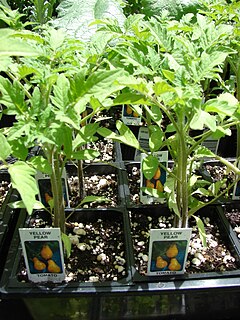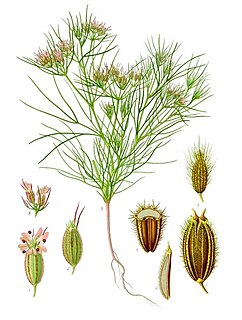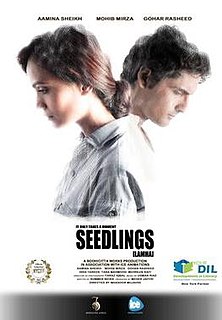
A cotyledon is a significant part of the embryo within the seed of a plant, and is defined as "the embryonic leaf in seed-bearing plants, one or more of which are the first leaves to appear from a germinating seed." The number of cotyledons present is one characteristic used by botanists to classify the flowering plants (angiosperms). Species with one cotyledon are called monocotyledonous ("monocots"). Plants with two embryonic leaves are termed dicotyledonous ("dicots").

In botany, the radicle is the first part of a seedling to emerge from the seed during the process of germination. The radicle is the embryonic root of the plant, and grows downward in the soil. Above the radicle is the embryonic stem or hypocotyl, supporting the cotyledon(s).

A spruce is a tree of the genus Picea, a genus of about 35 species of coniferous evergreen trees in the family Pinaceae, found in the northern temperate and boreal (taiga) regions of the Earth. Spruces are large trees, from about 20–60 m tall when mature, and have whorled branches and conical form. They can be distinguished from other members of the pine family by their needles (leaves), which are four-sided and attached singly to small persistent peg-like structures (pulvini) on the branches, and by their cones, which hang downwards after they are pollinated. The needles are shed when 4–10 years old, leaving the branches rough with the retained pegs. In other similar genera, the branches are fairly smooth.

Germination is the process by which an organism grows from a seed or similar structure. The most common example of germination is the sprouting of a seedling from a seed of an angiosperm or gymnosperm. In addition, the growth of a sporeling from a spore, such as the spores of hyphae from fungal spores, is also germination. Thus, in a general sense, germination can be thought of as anything expanding into greater being from a small existence or germ.

A seedbed or seedling bed is the local soil environment in which seeds are planted. Often it comprises not only the soil but also a specially prepared cold frame, hotbed or raised bed used to grow the seedlings in a controlled environment into larger young plants before transplanting them into a garden or field. A seedling bed is used to increase the number of seeds that germinate.

Plant propagation is the process of growing new plants from a variety of sources: seeds, cuttings, and other plant parts. Plant propagation can also refer to the artificial or natural dispersal of plants.

The endosperm is a tissue produced inside the seeds of most of the flowering plants following fertilization. It surrounds the embryo and provides nutrition in the form of starch, though it can also contain oils and protein. This can make endosperm a source of nutrition in animal diet. For example, wheat endosperm is ground into flour for bread, while barley endosperm is the main source of sugars for beer production. Other examples of endosperm that forms the bulk of the edible portion are coconut "meat" and coconut "water", and corn. Some plants, such as orchids, lack endosperm in their seeds.

Plugs in horticulture are small-sized seedlings grown in trays from expanded polystyrene or polythene filled usually with a peat or compost substrate. This type of plug is used for commercially raising vegetables and bedding plants. Similarly plugs may also refer to small sections of lawn grass sod. After being planted, lawn grass may somewhat spread over an adjacent area.

Seed predation, often referred to as granivory, is a type of plant-animal interaction in which granivores feed on the seeds of plants as a main or exclusive food source, in many cases leaving the seeds damaged and not viable. Granivores are found across many families of vertebrates as well as invertebrates ; thus, seed predation occurs in virtually all terrestrial ecosystems. Seed predation is commonly divided into two distinctive temporal categories, pre-dispersal and post-dispersal predation, which may involve different strategies and requirements and have different implications at the individual and population level. Nevertheless, regardless of timing, seed predation has great implications for plant population dynamics. To counterbalance effects of predation, plants have evolved defenses such as seed morphology and chemical defenses to defend against their seed predators. However, as plants have adapted defenses to seed predation, so have seed predators adapted to plant defenses. Thus, many interesting examples of coevolution arise from this dynamic relationship.
The Janzen–Connell hypothesis is a widely accepted explanation for the maintenance of tree species biodiversity in tropical rainforests. It was published independently in the early 1970s by Daniel Janzen and Joseph Connell. According to their hypothesis, host-specific herbivores, pathogens, or other natural enemies make the areas near a parent tree inhospitable for the survival of seedlings. These natural enemies are referred to as 'distance-responsive predators' if they kill seeds or seedlings near the parent tree, or 'density-dependent predators' if they kill seeds or seedlings where they are most abundant. Such predators can prevent any one species from dominating the landscape, because if that species is too common, there will be few safe places for its seedlings to survive. However, because the predators are host-specific, they will not harm other tree species. As a result, if a species becomes very rare, then more predator-free areas will become available, giving that species' seedlings a competitive advantage. This negative feedback allows the tree species to coexist, and can be classified as a stabilizing mechanism.

Hypogeal germination is a botanical term indicating that the germination of a plant takes place below the ground. An example of a plant with hypogeal germination is the pea. The opposite of hypogeal is epigeal.
The term seeding and related terms such as seeded are used in many different several contexts:

Cumin is a flowering plant in the family Apiaceae, native to a territory including the Middle East and stretching east to India. Its seeds – each one contained within a fruit, which is dried – are used in the cuisines of many cultures in both whole and ground form. Although cumin is thought to have uses in traditional medicine, there is no high-quality evidence that it is safe or effective as a therapeutic agent.

In plants, vivipary occurs when seeds or embryos begin to develop before they detach from the parent. Plants such as some Iridaceae and Agavoideae grow cormlets in the axils of their inflorescences. These fall and in favourable circumstances they have effectively a whole season's start over fallen seeds. Similarly, some Crassulaceae, such as Bryophyllum, develop and drop plantlets from notches in their leaves, ready to grow. Such production of embryos from somatic tissues is asexual vegetative reproduction that amounts to cloning.














